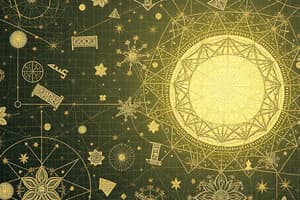Podcast
Questions and Answers
What does the study of trigonometry primarily focus on?
What does the study of trigonometry primarily focus on?
- The behavior of irrational numbers
- The analysis of statistical data
- The relationships between angles and sides of triangles (correct)
- The properties of algebraic functions
Which branch of mathematics primarily deals with the collection and interpretation of data?
Which branch of mathematics primarily deals with the collection and interpretation of data?
- Calculus
- Geometry
- Algebra
- Statistics (correct)
What is the formula for calculating the area of a circle?
What is the formula for calculating the area of a circle?
- A = πr² (correct)
- A = πd²
- A = 2πr
- A = πr/2
Which of the following represents a key component of algebra?
Which of the following represents a key component of algebra?
Which theorem is fundamental in geometry for establishing the relationship in right triangles?
Which theorem is fundamental in geometry for establishing the relationship in right triangles?
What does the average of a set of numbers represent?
What does the average of a set of numbers represent?
In the context of calculus, what are differentiation and integration primarily concerned with?
In the context of calculus, what are differentiation and integration primarily concerned with?
Which mathematical operation is primarily involved in finding the slope of a line?
Which mathematical operation is primarily involved in finding the slope of a line?
What constitutes discrete mathematics?
What constitutes discrete mathematics?
Which mathematician is recognized as the 'Father of Geometry'?
Which mathematician is recognized as the 'Father of Geometry'?
Flashcards are hidden until you start studying
Study Notes
Branches of Mathematics
- Arithmetic: Study of numbers and basic operations (addition, subtraction, multiplication, division).
- Algebra: Involves symbols and letters to represent numbers in equations and formulas.
- Geometry: Study of shapes, sizes, and properties of space; includes points, lines, surfaces, and solids.
- Trigonometry: Focuses on the relationships between the angles and sides of triangles.
- Calculus: Study of change and motion; consists of differentiation and integration.
- Statistics: Involves the collection, analysis, interpretation, and presentation of data.
- Probability: Study of randomness and uncertainty; calculates the likelihood of events.
- Discrete Mathematics: Deals with discrete elements that use algebra and arithmetic; includes graph theory and combinatorics.
Fundamental Concepts
- Numbers: Types include natural numbers, whole numbers, integers, rational numbers, and irrational numbers.
- Equations: Mathematical statements asserting the equality of two expressions (e.g., linear, quadratic).
- Functions: Relations that assign each input exactly one output; can be linear, quadratic, polynomial, etc.
- Theorems: Proven statements used to establish results (e.g., Pythagorean theorem in geometry).
- Proofs: Logical arguments establishing the truth of a statement; methods include direct, contradiction, and induction.
Mathematical Operations
- Addition/Subtraction: Basic operations that combine or remove quantities.
- Multiplication/Division: Operations for scaling quantities or distributing them into equal parts.
- Order of Operations: PEMDAS/BODMAS (Parentheses/Brackets, Exponents/Orders, Multiplication and Division, Addition and Subtraction).
Key Formulas
- Area of a Circle: A = πr²
- Circumference of a Circle: C = 2πr
- Volume of a Cylinder: V = πr²h
- Slope of a Line: m = (y2 - y1) / (x2 - x1)
- Quadratic Formula: x = (-b ± √(b² - 4ac)) / 2a
Applications of Mathematics
- Real-world Problem Solving: Used in finance, engineering, physics, biology, and economics.
- Data Analysis: Statistical methods for interpreting data trends and making predictions.
- Modeling: Creating mathematical models to simulate real-world situations.
Important Figures in Mathematics
- Euclid: Known as the "Father of Geometry"; wrote "Elements."
- Isaac Newton: Co-developed calculus; made significant contributions to physics and mathematics.
- Carl Friedrich Gauss: Made contributions to number theory, statistics, and analysis.
Study Tips
- Practice regularly: Solve various problems to strengthen understanding.
- Understand concepts: Focus on understanding the 'why' behind mathematical principles.
- Utilize resources: Use textbooks, online courses, and study groups for collaborative learning.
- Apply math in real life: Relate concepts to everyday scenarios for better retention.
Branches of Mathematics
- Arithmetic: Fundamental operations of addition, subtraction, multiplication, and division.
- Algebra: Utilizes symbols and letters to express numbers in equations, facilitating problem-solving and variable manipulation.
- Geometry: Analyzes shapes, sizes, and spatial properties including points, lines, surfaces, and solids.
- Trigonometry: Examines relationships in triangles, focusing on angles and side lengths.
- Calculus: Investigates concepts of change through differentiation (rates of change) and integration (accumulation of quantities).
- Statistics: Encompasses techniques for data collection, analysis, and interpretation to extract meaningful insights.
- Probability: Evaluates randomness by calculating the likelihood of various events occurring.
- Discrete Mathematics: Studies separate, distinct elements, including topics like graph theory and combinatorial analysis.
Fundamental Concepts
- Numbers: Categories such as natural, whole, integers, rational, and irrational, each with unique properties.
- Equations: Equalities representing relationships, including linear and quadratic forms.
- Functions: Mappings that assign a single output to each input; can be classified as linear, polynomial, or other types.
- Theorems: Established truths in mathematics (e.g., Pythagorean theorem) that serve as fundamental building blocks for further proofs and concepts.
- Proofs: Systematic logical deductions to confirm statements, employing methods like direct proof, proof by contradiction, and mathematical induction.
Mathematical Operations
- Addition/Subtraction: Fundamental methods for combining or separating numerical quantities.
- Multiplication/Division: Operations necessary for scaling quantities or dividing them into equal segments.
- Order of Operations: Rules encapsulated in PEMDAS/BODMAS to determine the sequence of performed operations in expressions.
Key Formulas
- Area of a Circle: A = πr², calculates the space within a circular boundary.
- Circumference of a Circle: C = 2πr, determines the distance around the circle.
- Volume of a Cylinder: V = πr²h, measures the capacity within a cylindrical shape.
- Slope of a Line: m = (y2 - y1) / (x2 - x1), indicates the steepness of a line connecting two points.
- Quadratic Formula: x = (-b ± √(b² - 4ac)) / 2a, provides solutions for quadratic equations.
Applications of Mathematics
- Real-world Problem Solving: Integral in fields like finance, engineering, physics, biology, and economics for optimal decision-making.
- Data Analysis: Employs statistical techniques to reveal trends and forecast outcomes from data sets.
- Modeling: Formulates mathematical representations to mimic and analyze real-life scenarios.
Important Figures in Mathematics
- Euclid: Pioneered geometry, notably through his work "Elements," which laid foundational principles.
- Isaac Newton: Contributed to the development of calculus, influencing both mathematics and physics significantly.
- Carl Friedrich Gauss: Renowned for advancements in number theory, statistics, and mathematical analysis.
Study Tips
- Practice regularly: Engage with diverse math problems to reinforce learning and application skills.
- Understand concepts: Prioritize grasping the reasoning behind mathematical processes rather than rote memorization.
- Utilize resources: Leverage textbooks, online courses, and cooperative study sessions for enhanced comprehension.
- Apply math in real life: Connect mathematical concepts to everyday situations to improve understanding and retention.
Studying That Suits You
Use AI to generate personalized quizzes and flashcards to suit your learning preferences.




